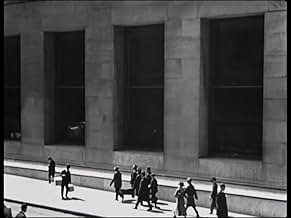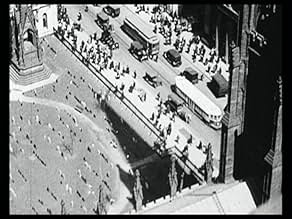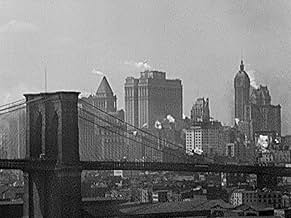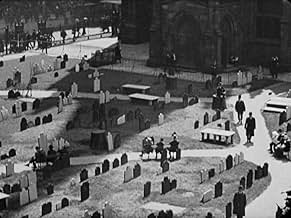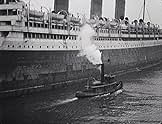IMDb रेटिंग
6.6/10
1.7 हज़ार
आपकी रेटिंग
अपनी भाषा में प्लॉट जोड़ेंThis groundbreaking silent documentary captures the beauty and majesty of the New York City in its streets, skyscrapers, bridges, rail yards and harbors.This groundbreaking silent documentary captures the beauty and majesty of the New York City in its streets, skyscrapers, bridges, rail yards and harbors.This groundbreaking silent documentary captures the beauty and majesty of the New York City in its streets, skyscrapers, bridges, rail yards and harbors.
- निर्देशक
- लेखक
- पुरस्कार
- कुल 1 जीत
फ़ीचर्ड समीक्षाएं
This experimental movie of Paul Strand about Manhattan is extremely important to the future generations of directors. Paul Strand is like a bird in Manhattan, showing the daily life and the most characteristic points of it. Manhattan is shown in a Bird's eye shot(I think that it's the name in English, kind like the public was God himself. I never went to Manhattan, but in 10 minutes I visited, understood and felt Manhattan. It is amazing how in such a short time, he can illustrate, in a interesting and original way, this mediatic place. Paul Strand is like a magician that takes photos of Manhattan and give life to them. A great short that definitely is a mark on cinema's experimental history.
Manhatta (1921)
**** (out of 4)
Cinematographer Paul Strand and painter Charles Sheeler teamed up to make this movie, which was their attempt to show their love for the city of Manhattan. The say they achieved in showing that love would be an understatement because this 11-minute movie is extremely well-made and contains some downright break taking visuals. The semi-documentary film has various images of the city put together in no real order nor do they try to tell a story out of the images. Instead we just see various items from the city, ranging from haze rising over buildings to various ships on the water. All of these images make for an incredible film because it really seems like you're watching a science-fiction film with a bunch of fake images. It's rather amazing at how well the cinematography is here because unlike many, or perhaps any film, this one here puts you so close to what you're looking at that it's nearly impossible to remember you're watching a movie. This is certainly one of the most beautiful looking films I've seen and perhaps the start of what would become avant-garde film and one has to wonder if Stanley Kubrick saw this and learned from it.
**** (out of 4)
Cinematographer Paul Strand and painter Charles Sheeler teamed up to make this movie, which was their attempt to show their love for the city of Manhattan. The say they achieved in showing that love would be an understatement because this 11-minute movie is extremely well-made and contains some downright break taking visuals. The semi-documentary film has various images of the city put together in no real order nor do they try to tell a story out of the images. Instead we just see various items from the city, ranging from haze rising over buildings to various ships on the water. All of these images make for an incredible film because it really seems like you're watching a science-fiction film with a bunch of fake images. It's rather amazing at how well the cinematography is here because unlike many, or perhaps any film, this one here puts you so close to what you're looking at that it's nearly impossible to remember you're watching a movie. This is certainly one of the most beautiful looking films I've seen and perhaps the start of what would become avant-garde film and one has to wonder if Stanley Kubrick saw this and learned from it.
Cinema had matured enough in the year 1921 to allow imaginative experimentation with celluloid. Two photographers combined Walt Whitman's lines of poetry with 65 filmed shots of New York City's Manhattan Island to produced their short movie 1921's "Manhatta." Some cite the pair's brief film as the first avant-garde work in moving pictures.
Charles Sheeler, a painter/photographer, and Paul Strand, photographer, decided to base their short project on passages from Whitman's 'Leaves of Grass.' They set their motion picture camera high above the city landscape, framing each of their 65 shots like they were using a still camera, dictating the artistry of the city's buildings and transport vehicles to determine its positioning. The camera rarely moves during each shot and sustains mostly wide shots of the city.
Not only does "Manhatta" serve as a fascinating historic photographic record of New York City over 100 years ago, it also reflects how humans apoear to be overwhelmed by the gigantic concrete structures and mammoth transports surrounding them. One particular visual exemplifying such magnitude is when a horde of workers crowd the stern of a ferry and unload in a rush to get where they need to go.
"Manhatta" was rarely shown after its completion, and when it did the movie was more of a curiosity. In 1950, a worn print of the short was discovered in a British film vault, and an archivist, beginning in 2005, spent four years to restore it to its current pristine form.
Charles Sheeler, a painter/photographer, and Paul Strand, photographer, decided to base their short project on passages from Whitman's 'Leaves of Grass.' They set their motion picture camera high above the city landscape, framing each of their 65 shots like they were using a still camera, dictating the artistry of the city's buildings and transport vehicles to determine its positioning. The camera rarely moves during each shot and sustains mostly wide shots of the city.
Not only does "Manhatta" serve as a fascinating historic photographic record of New York City over 100 years ago, it also reflects how humans apoear to be overwhelmed by the gigantic concrete structures and mammoth transports surrounding them. One particular visual exemplifying such magnitude is when a horde of workers crowd the stern of a ferry and unload in a rush to get where they need to go.
"Manhatta" was rarely shown after its completion, and when it did the movie was more of a curiosity. In 1950, a worn print of the short was discovered in a British film vault, and an archivist, beginning in 2005, spent four years to restore it to its current pristine form.
MANHATTA is an unusual short film. It's like the merging of a travelogue with a poem. So, as the camera moves artistically about the city of New York, the scenes are punctuated with intertitle cards that have poetic verse on them that make it all seem grand and majestic.
While much of this won't appeal to most viewers, the film is still worth seeing for two important reasons. First, the short is a wonderful historical record of the city. In other films of the era, New York is incidental, in a way. You might see bits and pieces of the city, but the city is not the star. Here, however, you see so much of the town that you wouldn't see otherwise--and much of it is gone today. Second, the film is very artistic in its cinematography--with wonderful aerial shots as well as nicely frames shots of the Brooklyn Bridge and the like.
Perhaps not exciting, but a rather important document. And, despite the original negatives being missing and only one print in existence until it was restored, the print looks great!
While much of this won't appeal to most viewers, the film is still worth seeing for two important reasons. First, the short is a wonderful historical record of the city. In other films of the era, New York is incidental, in a way. You might see bits and pieces of the city, but the city is not the star. Here, however, you see so much of the town that you wouldn't see otherwise--and much of it is gone today. Second, the film is very artistic in its cinematography--with wonderful aerial shots as well as nicely frames shots of the Brooklyn Bridge and the like.
Perhaps not exciting, but a rather important document. And, despite the original negatives being missing and only one print in existence until it was restored, the print looks great!
10DaveLB-3
Instead of having a filmmaker attempting to be painterly, this poetic gem boasts both a major painter (Sheeler) and a major photographer (Strand) collaborating.
This is the earliest view of Manhattan we have that is neither simple-minded documentation nor backdrop to melodrama. The visuals are striking, and stand up well to later, more gimmicky, film realizations of what makes Skyscraper National Park so special.
The Walt Whitman title cards would probably have worked better as voiceover narration in the sound era, but offer a strong romantic framework for the powerful imagery. A classic, not to be missed.
This is the earliest view of Manhattan we have that is neither simple-minded documentation nor backdrop to melodrama. The visuals are striking, and stand up well to later, more gimmicky, film realizations of what makes Skyscraper National Park so special.
The Walt Whitman title cards would probably have worked better as voiceover narration in the sound era, but offer a strong romantic framework for the powerful imagery. A classic, not to be missed.
क्या आपको पता है
- ट्रिवियाThe poet whose works are quoted during the film is Walt Whitman.
- भाव
Title Card - Walt Whitman: "City of the world - for all races are here, City of tall facades of marble and iron, Proud and passionate city."
- इसके अलावा अन्य वर्जनThis film was published in Italy on an DVD anthology entitled "Avanguardia: Cinema sperimentale degli anni '20 e '30", distributed by DNA Srl. The film has been re-edited with the contribution of the film history scholar Riccardo Cusin . This version is also available in streaming on some platforms.
- कनेक्शनFeatured in The Secret Life of Sergei Eisenstein (1987)
टॉप पसंद
रेटिंग देने के लिए साइन-इन करें और वैयक्तिकृत सुझावों के लिए वॉचलिस्ट करें
विवरण
- चलने की अवधि
- 11 मि
- रंग
- ध्वनि मिश्रण
- पक्ष अनुपात
- 1.33 : 1
इस पेज में योगदान दें
किसी बदलाव का सुझाव दें या अनुपलब्ध कॉन्टेंट जोड़ें

